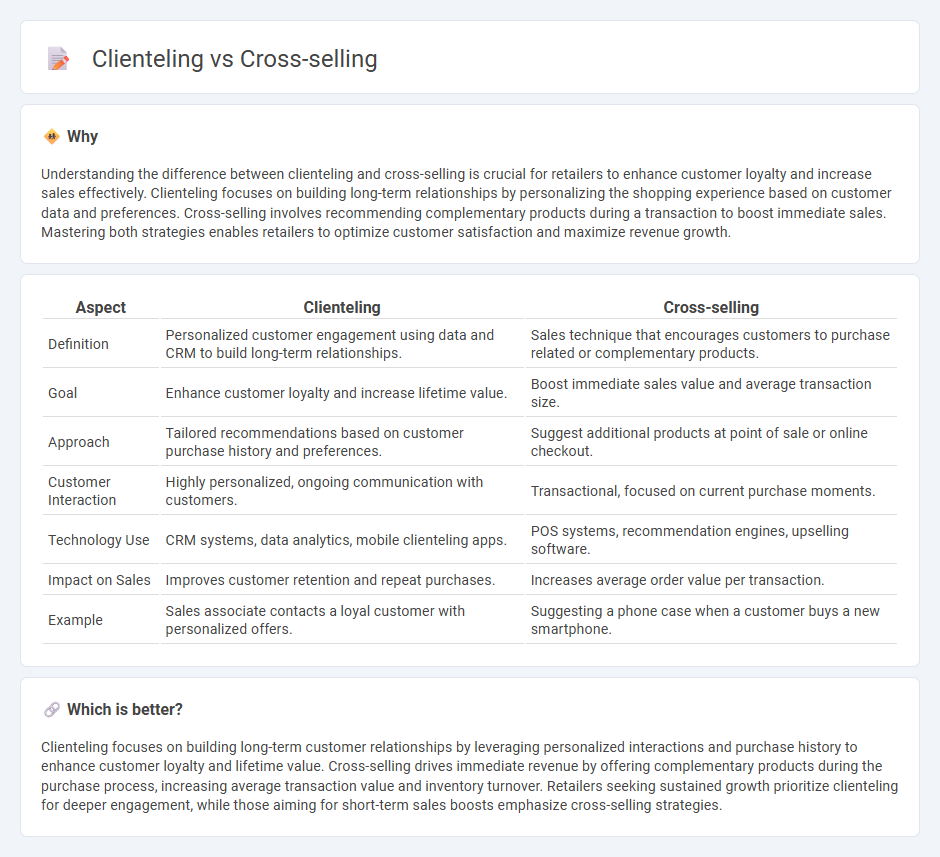
Clienteling focuses on building personalized customer relationships through tailored recommendations and one-on-one engagement, enhancing loyalty and repeat purchases. Cross-selling involves strategically suggesting complementary products to increase transaction value and boost overall sales within retail. Discover how integrating clienteling and cross-selling can transform your retail strategy and drive growth.
Why it is important
Understanding the difference between clienteling and cross-selling is crucial for retailers to enhance customer loyalty and increase sales effectively. Clienteling focuses on building long-term relationships by personalizing the shopping experience based on customer data and preferences. Cross-selling involves recommending complementary products during a transaction to boost immediate sales. Mastering both strategies enables retailers to optimize customer satisfaction and maximize revenue growth.
Comparison Table
| Aspect | Clienteling | Cross-selling |
|---|---|---|
| Definition | Personalized customer engagement using data and CRM to build long-term relationships. | Sales technique that encourages customers to purchase related or complementary products. |
| Goal | Enhance customer loyalty and increase lifetime value. | Boost immediate sales value and average transaction size. |
| Approach | Tailored recommendations based on customer purchase history and preferences. | Suggest additional products at point of sale or online checkout. |
| Customer Interaction | Highly personalized, ongoing communication with customers. | Transactional, focused on current purchase moments. |
| Technology Use | CRM systems, data analytics, mobile clienteling apps. | POS systems, recommendation engines, upselling software. |
| Impact on Sales | Improves customer retention and repeat purchases. | Increases average order value per transaction. |
| Example | Sales associate contacts a loyal customer with personalized offers. | Suggesting a phone case when a customer buys a new smartphone. |
Which is better?
Clienteling focuses on building long-term customer relationships by leveraging personalized interactions and purchase history to enhance customer loyalty and lifetime value. Cross-selling drives immediate revenue by offering complementary products during the purchase process, increasing average transaction value and inventory turnover. Retailers seeking sustained growth prioritize clienteling for deeper engagement, while those aiming for short-term sales boosts emphasize cross-selling strategies.
Connection
Clienteling enhances personalized customer interactions by leveraging purchase history and preferences, creating opportunities for targeted cross-selling where related products or services are recommended. Effective clienteling systems use data analytics to identify complementary items, increasing average transaction values and customer lifetime value. Integrating clienteling with cross-selling strategies drives sales growth and improves customer loyalty in retail environments.
Key Terms
Product Recommendations
Cross-selling leverages data-driven product recommendations to increase average order value by suggesting complementary items tailored to customer purchases. Clienteling prioritizes personalized interactions and in-depth customer profiles to offer relevant product suggestions that enhance loyalty and shopping experience. Explore how integrating both strategies can optimize product recommendations and boost sales effectiveness.
Customer Relationship Management (CRM)
Cross-selling enhances Customer Relationship Management (CRM) by promoting complementary products and increasing revenue per customer, while clienteling builds deeper, personalized connections through tailored recommendations and exclusive offers. Effective CRM integrates both strategies to maximize customer lifetime value and foster loyalty, leveraging data analytics and communication tools. Explore how combining cross-selling and clienteling within your CRM can transform customer engagement and drive business growth.
Personalization
Cross-selling leverages customer purchase history and preferences to recommend complementary products, enhancing average order value through data-driven insights. Clienteling emphasizes personalized interactions by building long-term relationships and tailoring experiences based on detailed customer profiles and behaviors. Explore how integrating both strategies can maximize personalization and drive customer loyalty.
Source and External Links
What Is Cross-Selling? Intro, Steps, and Pro Tips [+Data] - Cross-selling is a sales technique of offering customers additional products or services that complement their original purchase, distinct from upselling which offers upgraded versions of the original product.
Cross-Sell - Overview, How It Works, and Examples - Cross-selling involves selling related or complementary products or services alongside a customer's primary purchase, helping generate additional revenue and strengthen customer relationships when done effectively.
What is Cross-Selling? - Cross-selling increases sales and customer loyalty by identifying the right moments to offer supplementary products that enhance the customer's experience without replacing their original choice.
 dowidth.com
dowidth.com